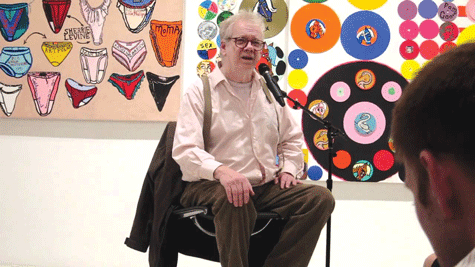By DORIS RUBENSTEIN
Like the wandering remnants of the Kingdom of Judah who finally found a home in Eretz Yisrael, the Minnesota Museum of American Art in St. Paul has ended its peripatetic journey and has settled into a permanent venue in Lowertown’s historic Endicott and Pioneer Buildings. The museum’s debut exhibition, “100 Years and Counting,” is now on display and the Children of Israel are well represented in it in various ways.

Just as the Jewish people have been known by many names over the millennia – Hebrews, Jews, Children of Israel (and a few I won’t favor to mention here) — the Minnesota Museum of American Art (self-referred to as “the M”) has had a tortuous identity crisis: Over its 117 year history, it has had seven names at one or another of its thirteen venues.
Founded in 1894, it was first called The St. Paul Institute of Art. Some senior readers of the American Jewish World may recall the M’s tenure in the sandstone mansion at 476 Summit Avenue when it was simultaneously the St. Paul Gallery and School of Art.
Although the early museum acquired art of all periods and areas, from the start the curators focused on American art, and particularly art by Minnesotans. Those emphases were strengthened during the 1990s.
With its new home — a work still in progress with an expansion scheduled to open in 2020, the new permanent collection has yet to enjoy a full exhibition. For the current show, the art is a mixture of works by visiting artists combined with art from the M’s own collection.
So, is there a Jewish connection beyond our shared wanderings? The current exhibition showcases numerous Jewish artists, national, international and local.
Prominently displayed as one enters the gallery area beyond a vast atrium, Theodore Roszak’s “Night Flight,” a surrealist image of ink and wash on paper from 1957, may be a commentary on the Holocaust, but we will never know. Roszak immigrated to the U.S. in 1907, so any experience with the Holocaust would not have been first-hand. Roszak is also identified as a mystic, but “Night Flight” bears no reference to Kabala.
Lucille Corcos, the daughter of Rabbi Joseph Corcos, who led New York’s Spanish-Portuguese Shearith Israel synagogue, delights the eye by giving us a peek inside an apartment building in her neighborhood in her modern-primitivist style. If you look carefully through the myriad of details in Sunday Morning 1944, you’ll see a set of Shabbat candlesticks on the sideboard.
With a Jewish father, we can generally claim one of the 20th Century’s most distinguished and influential photographers as our own: Margaret Bourke-White. Her portrait, “Gold Miner, Johannesburg, South Africa,” is dramatic. His eyes all at once engage us, beseech us, and challenge us while his posture makes a statement about his pride in his work and his identity.
Israeli Liat Jossifer, now resident in Los Angeles, lays her paint on the canvass so thickly that it forms an abstract bas-relief. Take a minute to scrutinize the swirls and you’ll see the hints of red and blue among the white. This explains the painting’s title: “The Americans.”
The Twin Cities’ own Frank Gaard has a large oil and bottle cap (it isa Frank Gaard painting, you know) untitled painting that I would say “out-Warhols” Andy Warhol himself! Gaard covers the huge canvas in dozens of variations of one cartoon caricature face, experimenting with changes in color that seem endless.
Jews in our community don’t have to be artists themselves to contribute to the collection at the M. St. Paul’s Mersky family has donated or pledged to donate several pieces from their collection, as has gallery owner Martin Weinstein. Our people have been generous donors to the M, as we are to virtually all of the arts institutions in the Twin Cities.
The M offers more than just gallery-strolling in its new spacious home. There are classes for all ages. Visiting artists will have lectures and demonstrations. It’s a great place for a party! So, welcome home, Minnesota Museum of American Art! Does anyone have an extra mezuza to give them?
***
“100 Years and Counting” is on display through Feb. 17 at the Minnesota Museum of American Art, 350 Robert St. N., St. Paul. For information visit mmaa.org.




















